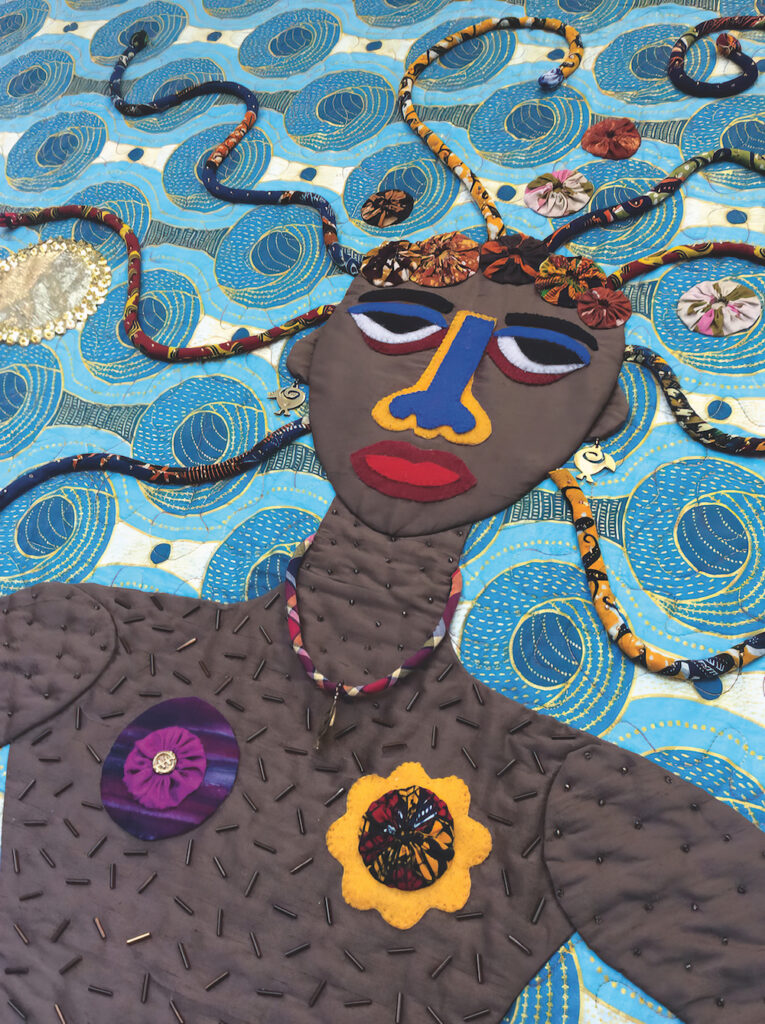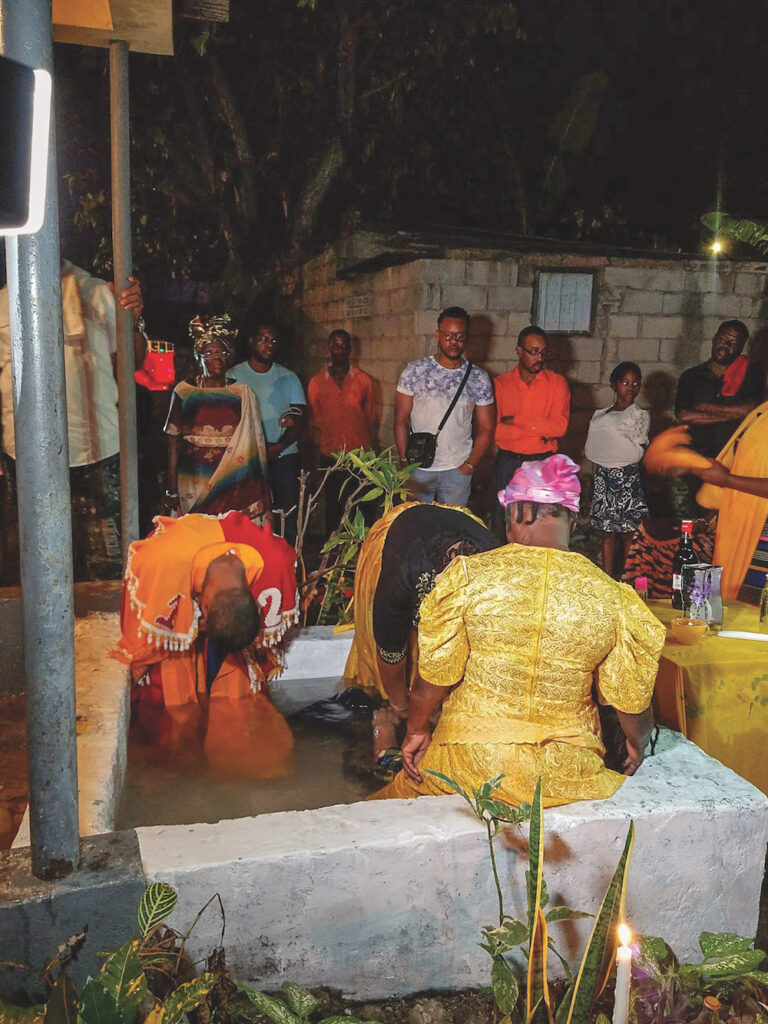THIS STORY BEGINS with a Jamaican folk tale about a mermaid spirit who inhabits the rivers, and sometimes the seas, of Jamaica. She’s a primordial and archetypal spirit affectionately, and even dreadfully, called River Mumma, River Maid, or The Maid:
Legend says that River Mumma inhabits the rivers of Jamaica, and all the fish are River Mumma’s children. Sometimes, people say, River Mumma rises out of the river to sit on the rocks and comb her long, black hair. But, like they say, don’t touch River Mumma. Don’t even look at her. There’s no telling what she will do if you try. Some say if you so much as see her, you’ll fall into a trance and she’ll grab you by the heels and drag you under the river. If you try to catch her, the fish will disappear; the river will run dry. It’s best, they say, not to make trouble with River Mumma. River Mumma lives in deep rivers, way down in those places where the water is tranquil, still and achingly blue, in spots beneath the shade of cotton trees, rimmed with plumes and spears of palms and overhung with ferns and ropes and vines of plants. It is there, they say, in those still places, way down at the bottom of the river, that the Golden Table lies hidden. The Spaniards left this table, made of solid gold, during their quest for gold many centuries ago. River Mumma guards that table. But often at noon, on the hottest of blazing-hot days, the Golden Table will rise slowly to the surface and hover there. When the greedy see that table, they long to steal it. Many have tried and have been pulled all the way to the bottom. That, they say, is what happens to anyone who tries to steal the Golden Table. (Friedman 2011)
What wisdom might we glean from the cautionary tale of a vengeful mermaid spirit who resides in the rivers of Jamaica? There is a long answer that flows into the Atlantic Ocean, stretching beyond the Kalunga line1 and into otherworldly dimensions that hold histories of tortured crossings, the ill-begotten gains of colonialism and transatlantic slavery, revealing the energies of primordial spirits that journeyed alongside the captives to their unwelcoming new home (Brown 2021). River Mumma is a riverine social theorist who can help us to understand the transoceanic circuits, transactions, and exchanges that form the geographic and conceptual space known as the Black Atlantic, which geographically encompasses Latin America, North America, West Africa, and the Caribbean, but whose boundaries extend beyond geography to a broader trans-atlantic culture produced through these circuits.

The folktale warns that if you try to catch River Mumma, the fish will disappear and the river will run dry. River Mumma reveals the wisdom of the original inhabitants of the land, the Indigenous Taínos who named the land that is now called Jamaica, Xaymaca, meaning land of wood and water. This wisdom flows into the subsequent keepers of the land, descendants of enslaved Africans, who prophesied the current climate crisis centuries ago as a time when the rivers would run dry and all the fish would disappear because of unethical and unbridled consumption that eschews reciprocity—hallmarks of late-stage capitalism.
Moreover, The Maid calls us into transatlantic waters and urges us to consider reciprocity, kinship, and our connection to one another. Who are the fish? Who are River Mumma’s children, and what does this riverine spirit have to do with spirituality in the present?
Jamaican Revival Zion and Its Practitioners
The Maid is a cardinal avatar within Jamaican Revival Zion religion. Revival Zion is a Kongo-heritage indigenous religion of Jamaica that was spread to Panama because of labor-related migrations. It interweaves Christianity with Central African and some West African religious practices. Contemporary popular discourses about Revival Zion tend to revolve around the propriety (or lack thereof) of the religion and its practitioners. It is often conflated with colonial renderings of Obeah, which is a contentious Anglo-Caribbean catchall term for sorcery and supernatural practices of a malevolent nature that is seen as posing a threat to Protestant morality and order. Any practice identified as Obeah, like Revival Zion, is in a precarious position under the law. Additional elements of the criminalization, suspicion, and, at times, even persecution of Revival practices in Jamaica have to do with the growing numbers of queer male practitioners, who are predominantly Black and are seen as an increasingly core constituent of the practice.
While Revivalists self-identify as Christians, they also acknowledge a world of spirits and practices that are primarily African, but also multi-ethnic. Revivalists work with various spirits and messengers who belong to what are called “nations.” Practitioners access these nations through the embodied ritual of journeying, wherein they enter a trance-state lasting hours, days, or even months. During spiritual journeys, practitioners report traveling to other lands and spiritual cities where they fight spiritual battles, and gain spiritual codes and keys, before returning to this corporeal realm. The most prominent nations are spiritual Africa, spiritual China, spiritual India, and, what I call in my larger work, geospiritual locales, like The River. The River Nation is where we meet River Mumma and her children.
Revival Zion and the Concept of Twofold
Revival Zion is divided into two orders—the 60 and 61 Orders respectively. Within the Revival universe, not only is there a concept of all-nations, but there is the concept of being twofold, of both 60 and 61, and this concept of twofold, I argue, is foundational to creating alternative spaces within Revival for various subjectivities, intimacies, and ways of being that are malleable. My larger work shows that in spite of ongoing repression aimed at foreclosing possibilities for Black religious subjects, Revivalists’ world-sense2 makes space for non-normative subjectivities, sensory dynamism, intimacies, relationships, and ways of being, doing, and moving that are deeply rooted in Africana sensory and spiritual-religious logics.

I posit that being twofold in Revival serves very similarly to the Native American concept of two-spirit people; that is, twofold people are neither male nor female but are gender-variant and, through spiritual intervention, fill special religious roles as healers, shamans, and ceremonial leaders. Through my research, I see this resonance within Revival as well, where the most gifted healers, leaders, and readers are “all-nations” or twofold, and also exhibit various forms of creative gender variation.
River Mumma herself is twofold—half fish, half-human; half-ancestor, half-primordial spirit; mostly female but sometimes nonbinary. I argue that analyses of African and African diasporic mermaid spirits offer opportunities for realizing afro-queer personhood. In particular, the Brazilian “Mother of Fish,” Yemanjá; historical West and Central African renderings of Mami Wata from groups like the Ibibio; and the Haitian loa/spirit Lasiren are most closely related to the Jamaican River Maid. These figures, as Omise’eke Tinsley argues of Haitian Vodou, possess the ability to inspire and protect “creative genders and sexualities” by figuring them as central to the sacrality of the religion, be it through divinely ordained roles as healers, vessels of the spirit, or manifestations of facets of the spirits (Tinsley 2018).
Revival Zion’s river rituals provide an afro-queer rewrite to mainline Christian water baptism. Dianne Stewart notes that nineteenth-century missionaries who visited Jamaica “detested the embodied spirituality and sensuality of enslaved Africans and required that they refrain from participating in any such gatherings as a prerequisite for baptism and acceptance into the Christian community” (2005, 86). Stewart further notes that Africans were required to choose between the binary choices: African dance and spirituality or Christianity. I suggest that Revivalists chose both. The Revival pool or river is an afro-queer baptism on sacred ancestral grounds outside of the edifice of the church, where Eurochristian principles are turned on their head in favor of more fluid dynamisms and expression. As missionaries spoke of “detestable transactions”3 within African gatherings, today’s Revivalists still engage in these somatic transactions with spirits that upend traditional Christian sacraments, affording practitioners access to spiritual manifestation and non-temporal dimensions that are simply more immediately rewarding.
Water as a Site of Transformation
Ras Michael Brown discusses the journey from the land of the living to that of the dead, noting that it requires passage through the water, “which serves as both a window or door and a great barrier between the two lands” (Brown 2012, 95). He underscores that movement through the water establishes connections between the realms of the living and the dead and represents processes of transformation. I offer Revival’s River Nation as a space where practitioners are called to The River or the sea, where they cross the waters again and again, resulting in spiritual and physical transformations. These transformations disrupt normative time-space, racial, ethnic, and gendered configurations, bringing to the fore non-normative potentials within Revival Zion. Here, River Mumma’s presence and her teachings are profound and palpable. In right relationship with the riverine spirit, practitioners are provided locally situated, but transnationally relevant, tools and sensibilities that expand ways of doing and being within an Africana epistemological framework, all while creating lives and envisioning new kinds of futures through fluid forms of belonging. ✹
Khytie K. Brown, an assistant professor in the UT Austin Department of Religious Studies, is an ethnographer and scholar of African diaspora religions. Her research examines the intersections of religion, race, gender and sexual alterity, criminality, material culture, sensory epistemologies and social media practices among African diasporic religious practitioners in the Caribbean, Latin America, and North America.
The February 2023 Lozano Long Conference was an interdisciplinary exploration of the central role of water in Latin America and the Caribbean. Presenters in history, geosciences, hydrology, archaeology, conservation, cultural studies, Afro-Caribbean spirituality, and human rights shared their research with a broad and engaged audience. Assistant Professor of Religious Studies Khytie K. Brown was one of two presenters contributing research on spiritual-cultural practices surrounding water.
Notes
1. The Kalunga line is a concept in the Kikongo language that refers to a watery boundary or threshold between worlds. In particular, this boundary separates the realm of the living and the dead and is central to African diasporic understandings of transatlantic crossings that took enslaved Africans from life unto literal and soul-death after they crossed the Atlantic in bondage.
2. I borrow “world-sense” from Oyěwùmí (1997).
3. Wesleyan minister Thomas Coke, quoted in Stewart (2005, 87).
References
Brown, Khytie K. 2021. “Mermaids and Journeymen: Revival Zion and Africana Religious Futures.” Black Theology 19, no. 3: 229–39.
Brown, Ras Michael. 2012. African-Atlantic Cultures and the South Carolina Lowcountry. Carbondale: Southern Illinois University; Cambridge: Cambridge University Press.
Friedman, Amy. 2011. “Tell Me a Story: River Mumma and the Golden Table (a Jamaican Folktale).” GoSanAngelo, April 30.
Oyěwùmí, Oyèrónké. 1997. The Invention of Women: Making an African Sense of Western Gender Discourses. Minneapolis: University of Minnesota Press.
Stewart, Dianne M. 2005. Three Eyes for the Journey: African Dimensions of the Jamaican Religious Experience. New York: Oxford University Press.
Tinsley, Omise’eke Natasha. 2018. Ezili’s Mirrors: Imagining Black Queer Genders. Durham, NC: Duke University Press.

